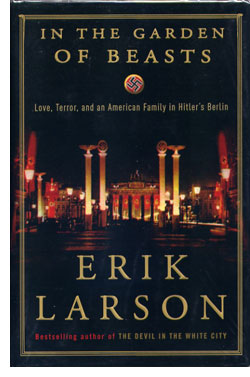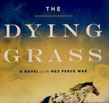 |
 |
 Erik Larson
Erik Larson
In the Garden of Beasts
Reviewed by: Rick Kleffel © 2011
Crown Books / Random House
US Hardcover First Edition
ISBN 978-0-307-40884-6
Publication Date: 05-10-2011
450 Pages ; $26
Date Reviewed: 07-10-2011
Index:
Non Fiction
General Fiction
Horror
Great writing can undermine hindsight. Events we feel to be fixed in our minds can be made to vanish by the powers of prose. The first histories may indeed be written by the victors, but the most informative offer the viewpoint of the vanquished. It is not enough to know what happened, to understand the changes that come about.
It is far more important to understand why events unfolded as recorded, to be immersed in the minds of those making the best decisions they knew to make, especially if their voices went unheeded. Offer readers a true perception from the past and the future will be forgotten.
Erik Larson manages this difficult feat with 'In the Garden of Beasts,' his gripping story of William E. Dodd, the American Ambassador sent to Germany just before Hitler seized power. Accompanied by his family, including his vibrant daughter Martha, the mild-mannered Dodd, who called himself a "Jeffersonian Democrat," found himself in a seething cauldron of nascent evil. He could not know what was to come.
Larson's triumph is to put readers in Dodd's world. It is about to explode in violence and horror. 'In the Garden of Beasts' is a creepy, disturbing page-turner that brilliantly re-creates a world that does not know what we all know. In doing so, Larson enables readers to understand the psychology of those who found themselves face-to-face with Hitler and the Nazis before the power of their evil was unleashed upon the world.
'In the Garden of Beasts' is assiduously researched. Everything you read is scrupulously backed by existing documents. But by restricting his focus to a single year; 1933 to 1934, and by assembling documents that had not been put together in this manner, Larson creates a unique portrait of innocent, almost bumbling Americans unknowingly set adrift in what was to become the most evil and destructive regime of the 20th century. The compression of time lends an element of incredible tension. 'In the Garden of Beasts' reads like a dystopian political horror novel.
Larson focuses on two characters; William E. Dodd himself, the Ambassador, and his daughter, Martha. Dodd was a self-made academic from a poor background. President Roosevelt, who was trying to steer the country out of the Depression, sent Dodd to Germany mostly as an afterthought. At the time, Germany wasn't all that important, except as a debtor country. It owed America lots of money that certainly could help ease our economic nightmare, and could make things worse if it defaulted.
Dodd found himself dealing with American isolationists, an elitist diplomatic corps that its rich and entitled members considered a "pretty good club," in a country that was in the grip of deadly and often murderous social upheaval. Hitler was Chancellor but Hindenburg was President. The Nazis had a lot of power, but were by no means running the show. Even the Nazis were divided. Dodd could sense trouble, but had little sway back in Washington.
Martha, a pretty, smart and fashionable young woman of 25, at first found the Nazis engagingly exciting. The young men were handsome and enthusiastic. Berlin was lively and cosmopolitan. She received love letters from Carl Sandburg and dated Rudolf Diels, who was in charge of the Gestapo. Martha found it all very exhilarating, and played the social scene with verve. She had a date with Hitler. It was not a grand success, however.
All this time, the Nazis were consolidating their power, reaching into society in ways both subtle and overt. Larson puts readers so firmly in the perceptions of his characters, that the experience of the book renders our knowledge of the outcome irrelevant. Larson's powerful character arcs, bolstered by astonishing details, create a powerful, page-turning plot.
No matter how much you think you know about what happened, immersing yourself in Larson's tight, taut narrative and engaging characters will result in a breathless, page-turning experience. Of course, there are many modern parallels to the events chronicled in this work of non-fiction, and they're open to a variety of interpretations. But there's no escaping the grip of this superb book. Close the covers. You're living in the epilogue.
|
 |
|
|
 |
| |
Review Archive
All Reviews alphabetized by author.
General Fiction
Non-Genre, general fiction and literature.
Horror
Supernatural fiction, supernatural horror and non-supernatural horror.
Science Fiction
Science fiction, science fantasy, speculative fiction, alternate history.
Fantasy
Fantasy, surrealism and magic realism.
Mystery
Crime, thrillers, mystery, suspense.
Non-Fiction
Non-Fiction, True Crime, Forteana, Reference.
Poetry
|
|
 |
|




